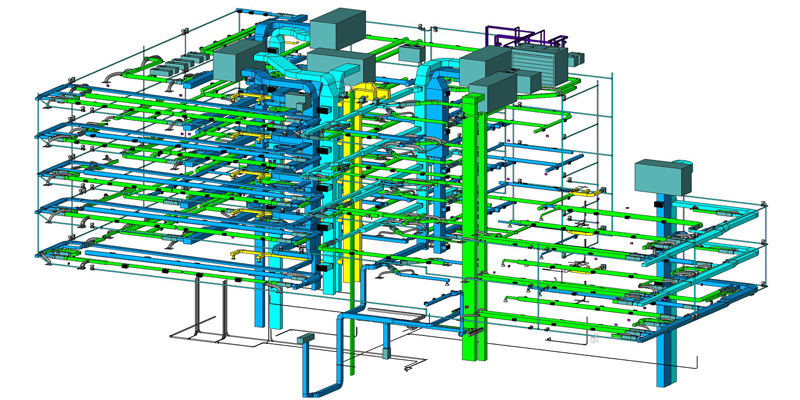In the dynamic and ever-evolving realm of construction and engineering, efficiency, precision, and sustainability are not just aspirations but essential benchmarks. At the heart of every successful project lies the seamless coordination of Mechanical, Electrical, and Plumbing (MEP) systems. These intricate systems form the backbone of any modern structure, ensuring functionality and comfort for occupants. However, achieving this harmony can be a formidable challenge, especially in complex projects like those in Dubai. Fortunately, MEP BIM Modeling Services have emerged as the answer to these challenges, offering a new level of excellence in construction coordination and management.
The Complexity of MEP Systems
MEP systems are the unsung heroes of any building. These systems encompass everything from heating, ventilation, and air conditioning (HVAC) to electrical distribution, plumbing, and fire protection. The complexity arises from the interdependence of these systems. For instance, the placement of electrical conduits affects the layout of HVAC ducts, and both must be seamlessly integrated into the building’s structure while adhering to safety codes and sustainability goals.
Here are some key challenges posed by MEP systems in construction:
Coordination and Clash Detection
The intricate nature of MEP systems often leads to clashes and conflicts when they are not adequately coordinated. A clash might occur when a ductwork path intersects with an electrical conduit or when plumbing clashes with fire protection systems. Detecting and resolving these clashes manually can be time-consuming and costly, often resulting in project delays and budget overruns.
Space Optimization
In densely populated urban centers like Dubai, space is a precious commodity. MEP systems must be designed to maximize space utilization while adhering to safety and functionality requirements. This is a delicate balancing act that requires careful planning and coordination.
Sustainability and Efficiency
Dubai places a strong emphasis on sustainability and energy efficiency in construction. Achieving these goals necessitates the use of advanced technologies and innovative design solutions in MEP systems. Optimizing energy usage, reducing waste, and incorporating green technologies are critical components of modern MEP design.
The Role of MEP BIM Modeling Services
MEP BIM modeling services represent a paradigm shift in construction coordination and management. By harnessing the power of digital modeling, these services offer a range of benefits that address the challenges posed by MEP systems:
3D Visualization and Coordination
MEP BIM services enable the creation of detailed 3D models that accurately represent Mechanical, Electrical, and Plumbing systems within a building. This level of detail allows architects, engineers, and contractors to visualize and coordinate these systems with unprecedented accuracy. Potential clashes and conflicts can be identified and resolved during the design phase, eliminating costly rework during construction.
Interdisciplinary Collaboration
One of the greatest strengths of MEP BIM modeling services is their ability to facilitate interdisciplinary collaboration. Architects, structural engineers, and MEP engineers can work together within the same BIM environment. This ensures that MEP systems are seamlessly integrated into the overall building design, avoiding conflicts and optimizing space utilization.
Clash Detection and Resolution
Automated clash detection is a standout feature of MEP BIM modeling. The software identifies clashes between different MEP elements or with structural components, down to the millimeter. This proactive approach prevents construction delays, cost overruns, and post-construction issues, ultimately saving both time and money.
Energy Efficiency and Sustainability
MEP BIM services are well-aligned with Dubai’s commitment to sustainability and energy efficiency. Engineers can simulate and analyze the energy performance of MEP systems, ensuring that buildings are designed for maximum energy efficiency and minimal environmental impact. This includes optimizing HVAC systems, lighting, and insulation to minimize energy consumption.
Real-World Applications of MEP BIM Modeling
To understand the profound impact of MEP Services, let’s explore how they are applied in real-world scenarios:
High-Rise Buildings
Dubai is renowned for its iconic skyscrapers, and MEP BIM modeling is instrumental in their construction. Efficient vertical transportation systems, climate control, and electrical distribution are essential in these structures. MEP BIM ensures that these systems are seamlessly integrated into the building’s design, contributing to both functionality and aesthetics.
Sustainable Developments
Sustainability is a top priority in Dubai’s construction projects. MEP BIM Services enable engineers to design and analyze green building technologies such as solar panels, efficient HVAC systems, and water-saving plumbing solutions. These technologies not only reduce environmental impact but also offer long-term cost savings.
Iconic Landmarks
Dubai’s iconic landmarks, rely on MEP systems that provide comfort, safety, and functionality to thousands of occupants. MEP BIM modeling ensures that these systems are not just state-of-the-art but also optimized for sustainability, aligning with Dubai’s vision for the future.
Commercial Spaces
In bustling commercial areas, such as Dubai’s business districts, efficient MEP systems are essential for the comfort and productivity of occupants. MEP BIM modeling ensures that these systems are designed to cater to the specific needs of each space, whether it’s a corporate office, a shopping mall, or a healthcare facility.
The Future of MEP BIM Modeling Services
As technology continues to advance, the future of MEP BIM modeling services holds even more promise:
Integration with IoT
The Internet of Things (IoT) is becoming increasingly prevalent in building management. MEP BIM models can be seamlessly integrated with IoT sensors and systems, allowing for real-time monitoring and control of MEP systems. This integration enables predictive maintenance, energy optimization, and enhanced user experiences
AI-Driven Analysis
Artificial intelligence (AI) is making its way into BIM modeling services. AI algorithms can analyze vast datasets generated by building systems, identifying trends and anomalies in MEP system performance. This enables proactive maintenance, energy optimization, and cost reduction.
Augmented Reality (AR) and Virtual Reality (VR)
AR and VR technologies are being integrated into MEP BIM modeling. This allows stakeholders to experience and interact with MEP systems in immersive virtual environments, fostering better understanding and decision-making during the design and construction phases.
Cloud-Based Collaboration
The shift towards cloud-based MEP BIM platforms is accelerating. This enables remote collaboration, making it easier for global teams to work together seamlessly. Cloud-based solutions enhance accessibility, data sharing, and real-time updates, ensuring everyone is on the same page.
Conclusion
Engisoftengineering MEP Services have emerged as a beacon of excellence in the construction industry. They empower architects, engineers, and contractors to achieve a new level of precision, efficiency, and sustainability in their projects. In Dubai, where iconic skyscrapers, sustainable developments, and cutting-edge commercial spaces are the norm, MEP BIM plays a pivotal role in shaping the future of construction.
These services ensure that buildings are not just structures but highly efficient, sustainable, and technologically advanced spaces. As technology continues to advance, the potential for BIM modeling services to drive innovation in construction remains limitless, setting the stage for a brighter, more sustainable future in Dubai and beyond.
READ MORE ;
https://urweb.eu/what-are-the-business-benfits-of-cheapest-stickers/




